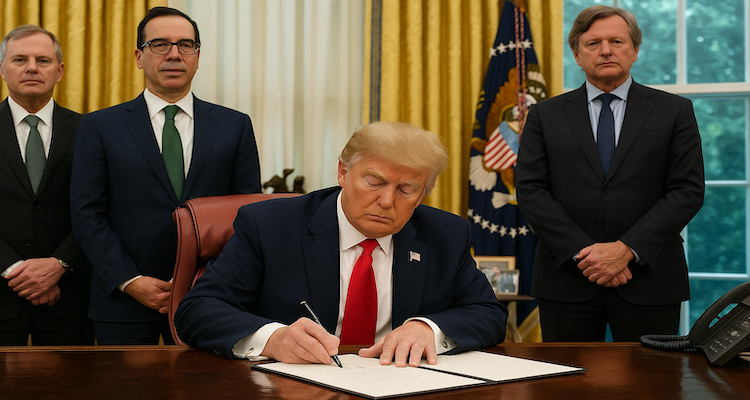India and U.S. Set Stage for Landmark Trade Deal
India and the U.S. have launched the first phase of a major trade deal, aiming to reach $500B in bilateral trade by 2030.
India and U.S. Kick Off Historic Trade Talks to Boost $500B Goal
By [Your Name]
In a move poised to reshape economic ties between two of the world’s largest democracies, India and the United States have formally initiated the first phase of a long-anticipated trade agreement. The announcement marks a significant stride toward reducing trade barriers and deepening economic engagement between the two nations.
Trade Secretary Sunil Barthwal confirmed the breakthrough on Tuesday, emphasizing India’s commitment to a path of trade liberalization with the U.S. The two governments signed the terms of reference to lay the groundwork for virtual discussions this month, followed by in-person negotiations slated for mid-May.
“This is a forward-looking partnership,” Barthwal told reporters. “India is ready to embrace more open trade with the United States.”
Aiming for $500 Billion in Bilateral Trade
The renewed push for collaboration stems from a February agreement during Indian Prime Minister Narendra Modi’s visit to Washington. Both sides pledged to expedite a phased trade pact with the ambitious goal of reaching $500 billion in bilateral trade by 2030—a significant leap from current levels.
Trade between the two countries has grown steadily but remains imbalanced. In 2023, the U.S. reported a trade deficit of $45.6 billion with India. To help close the gap, India has signaled its willingness to cut tariffs on more than half of U.S. imports valued at $23 billion—potentially the largest such tariff reduction in years.
This unprecedented move would not only ease market access for American goods but also position India as a more attractive trade partner amid a shifting global economic order.
Trump’s Temporary Tariff Pause Offers Breathing Room
Coinciding with the announcement, U.S. President Donald Trump introduced a 90-day suspension on most tariff hikes for key trading partners, including India. While the move is largely viewed as a reprieve amid growing global trade tensions—especially with China—it also provides Indian exporters a much-needed window of relief.
However, tensions haven’t entirely subsided. Despite Modi’s early diplomatic outreach after Trump’s return to the White House, the U.S. president has repeatedly criticized India’s tariff policies, branding the country a “tariff abuser” and “tariff king.”
The Biden administration’s earlier efforts to reset trade relations seem to have gained modest traction, but Trump’s return to power has added a new layer of unpredictability. Yet, both governments appear determined to move forward pragmatically.
Beyond Tariffs: Defense, Energy, and Strategic Stakes
India’s broader trade strategy includes pledges to ramp up imports of U.S. defense and energy products—critical sectors where cooperation could cement long-term strategic ties.
According to Rajesh Agrawal, Additional Secretary in India’s Trade Ministry, these discussions are “not just about tariff cuts but about deepening economic interdependence.” The evolving trade framework will likely address intellectual property rights, digital trade, and services—areas of increasing interest to both economies.
India’s growing consumer base, expanding tech ecosystem, and clean energy ambitions make it a vital market for American companies. Meanwhile, the U.S. remains India’s largest export destination, underscoring the mutual benefits of smoother trade flows.
Toward a More Balanced Global Trade Architecture
This trade initiative unfolds against the backdrop of a global tariff war that’s reshaping traditional alliances. Finance Minister Nirmala Sitharaman’s upcoming visit to the U.S. is expected to further align economic strategies and reinforce the message that India is ready to be a more integrated player in global trade.
While the road to a final trade agreement may still be complex, the momentum generated by this first phase sets a positive tone. A successful deal would signal not just economic alignment but a shared commitment to fair, rules-based trade in an increasingly fragmented world.
Conclusion: A Defining Chapter in Indo-U.S. Trade Relations
As India and the United States begin a new chapter in their trade relationship, the stakes couldn’t be higher. A mutually beneficial agreement could serve as a blueprint for other global partnerships and reinforce economic stability in an era of uncertainty.
The coming months will test the two nations’ ability to bridge differences and negotiate in good faith. But with clear intent, strategic alignment, and a $500 billion goal in sight, the groundwork has been laid for a transformative economic partnership.
Disclaimer:
This article is based on recent developments in Indo-U.S. trade negotiations and aims to provide an informed summary of the events. For official policy positions and legal interpretations, readers should refer to statements from the respective governments and trade authorities.
source : The Economic Times











